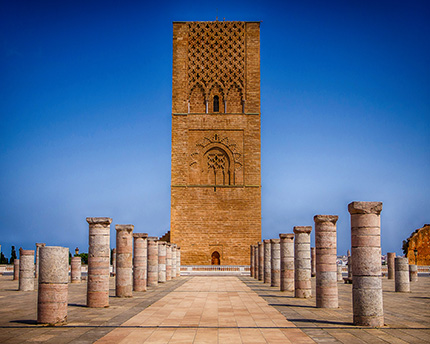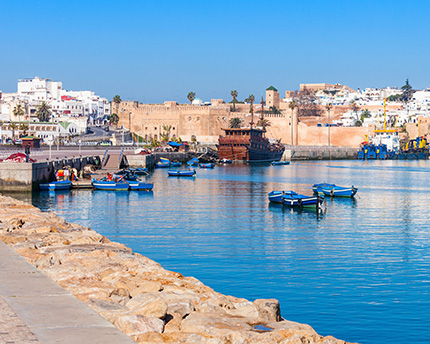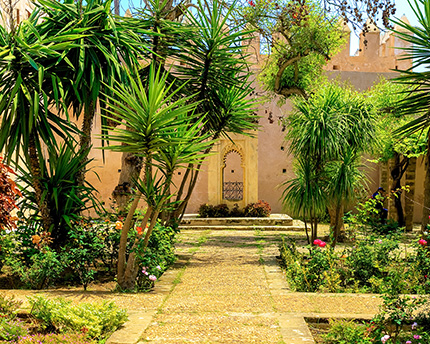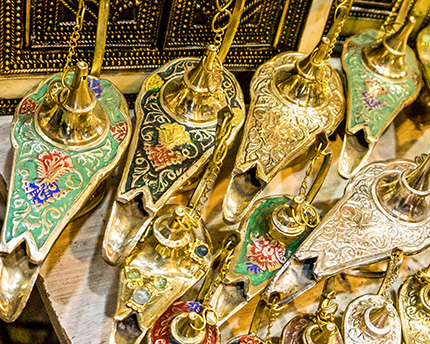The Hassan Tower (also known as the Beautiful Tower) is one of Rabat’s great landmarks. It was part of a colossal architectural project, surrounded by gardens, commissioned by Sultan Ya’qub al-Mansur in the 12th century near the estuary of the Bou Regreg River. The building was originally intended to be part of what was to be the second-largest mosque in the world after the Samarra Mosque in Iraq. However, the sultan died before seeing his pharaonic work completed, and in 1755 an earthquake destroyed everything that had been built. Today, only the monumental Hassan Tower and the architectural structure of the planned mosque remain as a testament to the grandeur of al-Mansur’s dream in 1195. Some say that the sultan intended to make Rabat his new imperial capital, as the great mosque of which the tower formed part was out of proportion to the sparse population of Rabat at the time. Others say that it was merely intended to rival the magnificent Mosque of Córdoba, the former capital of the Islamic kingdom in the West.
History of the Hassan Tower
The Hassan Tower has a very long history. Not only was it the brainchild of Sultan Ya’qub al-Mansur in the 12th century, but it was also the iconic place from which King Mohammed V led the first Friday prayers after Morocco gained independence in 1955.
In the 12th century, Sultan Ya’qub al-Mansur, son of the previous Almohad caliph Abu Ya’qub Yusuf, had intended to build the largest mosque in the world, but he died before his time and no one followed up on his pharaonic project. In fact, the Hassan Tower (Rabat) should have been more than 70 metres high, but remained at the current height of 45 metres.
Today, the Hassan Mosque retains only the great tower, twin sister of the Giralda, and the base of the columns of the main building.
Very close to the Hassan Tower is the Mohammed V Mausoleum, built between 1961 and 1970 to house the remains of King Mohammed V and King Hassan II.

Architecture of the Hassan Tower
The Hassan Tower is the work of the same architect and is in the same style as the Koutoubia in Marrakesh and the Giralda in Seville. It is the third of the three sister towers. The Rabat mosque was built on a rectangular site measuring 190 metres by 140 metres, larger than that of the Great Mosque of Córdoba. At the time, it may have been the largest building in the Islamic world. At the foot of the Rabat Tower is a huge courtyard and what remains of the prayer hall, which must have consisted of 21 naves separated by rows of columns decorated with capitals, and some remains of the pillars are still standing.
The Hassan Tower is a square tower that stands 45 metres high. In theory, it should have reached 80 metres and exceeded the height of the Koutoubia and the Giralda in Seville, but it was never completed as planned. Each of its sides has blind lobed arches. At the top of the minaret, there is a grid of lozenges similar to that of the Giralda in Seville.
The interior of the Hassan Tower has six floors that are connected by a continuous ramp and all of them have a vaulted room. Rebuilt in 2013, the monument is built of reddish sandstone.
Information for visitors
Until recently, visitors were allowed to enter the interior of the Hassan Tower to see the views of Rabat and Salé from the top, but the architects noticed that the monument was deteriorating and decided to close it to the public. However, it is still considered a sacred place even today, where the daily calls to prayer are held.
Visitors can access the grounds from 6.00 to 18.00 every day and admission is free of charge.




































































